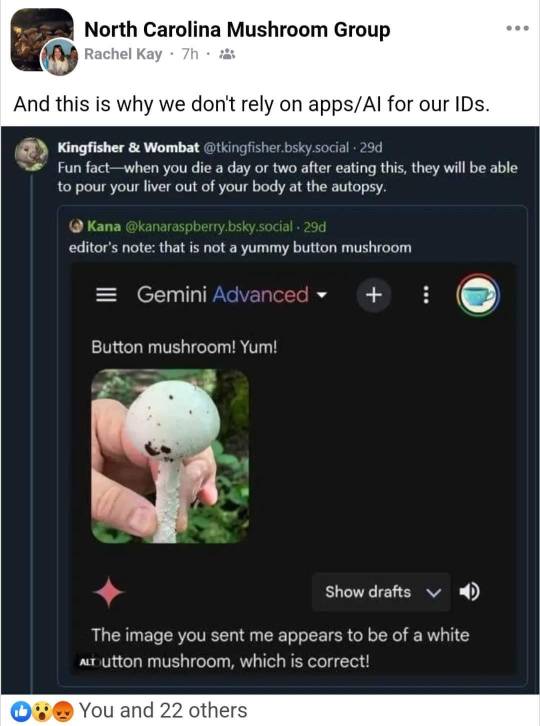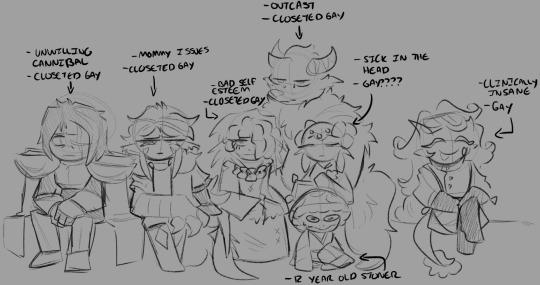#mushroom poisoning
Explore tagged Tumblr posts
Text
Just one drop and you're history "The Deadly Death Cap Mushroom"
youtube
#The Deadly Death Cap Mushroom#death cap mushroom#Amanita phalloides#mushroom toxicity#poisonous mushrooms#mushroom identification#foraging safety#symptoms of poisoning#mushroom poisoning#wild mushrooms#toxic fungi#first aid for mushroom poisoning#mushroom awareness#edible vs poisonous mushrooms#mycology education#fungal hazards#identifying death cap#mushroom foraging risks#toxic mushroom symptoms#awareness about death cap mushroom#mushroom#Youtube
2 notes
·
View notes
Text

Update of my favorite OC 🫶
#original work#my art#oc#original character#original story#art#digital art#mushroom oc#mushrooms#mushroom poisoning#oc art blog#oc art
10 notes
·
View notes
Text
Time to show off all of the wedding gowns!😳
What compliments will they get from the other Cookies?

#cookie run#cookie run kingdom#financier cookie#madeleine cookie#clotted cream cookie#kouign amann cookie#caramel arrow cookie#dark choco cookie#dark cacao cookie#crunchy chip cookie#mozzarella cookie#golden cheese cookie#smoked cheese cookie#burnt cheese cookie#schwarzwälder#poison mushroom cookie#licorice cookie#promotional image
4K notes
·
View notes
Text

✨🃏🍮🍓🥞🍄🧅🪄Scamming kids gone wrong ✨
He's getting flashbacks of his past 😌
#cookie run#cookie run kingdom#cookie run shadow milk#crk shadow milk cookie#shadow milk crk#shadow milk cookie#custard cookie the third#custard cookie iii#strawberry crepe crk#strawberry crepe cookie#pancake cookie#onion cookie#cream puff cookie#poison mushroom cookie
3K notes
·
View notes
Text
MEDICAL INFORMATION QUALITY RATING:
Source(s): 0/4
Authenticity/Timeliness: 2/4
Emotionality: 3/4
Total: 5/12 Information Quality: Mediocre Consideration: The way the information is provided appears to be indicative of misinformation. However, if the pictured mushroom is indeed the "Destroying Angel," then what is stated appears to be consistent with the literature.
---
Explanation: I am not a mycologist and thus cannot identify the mushroom pictured, but under the assumption that it is indeed the Amanita Mushroom, then it appears that "amanita virosa" is highly poisonous. The symptoms of amatoxin poisoning include gastrointestinal distress (e.g., stomach pain, nausea, vomiting, diarrhea) within 6 to 24 hours, then progression to the liver after about 12 hours (i.e., hepatitis) with the potential for some improvement, before liver and kidney failure around 24 hours with evidence of seizures, coma, brain edema, and encephalopathy. The patient is very likely to die at this final stage. The mechanism of action is that the creation of several important proteins are prevented--which are highly conducive for life. Thus, it appears that the OP and the reblogger's information is consistent with the current literature (if the mushroom pictured is indeed the amanita virosa mushroom).
---
Lower scores do not necessarily indicate mis- or disinformation, only that the way the information is provided should be considered critically. Always maintain skepticism and complete further research in all cases. Visit this blog for further details on rating system. I may make mistakes sometimes.

For those not in the know, this is one of the Amanita mushrooms referred to as a Destroying Angel. Never, ever, ever, ever forage with an app. Especially for mushrooms.
#mushrooms#AI#potential misinformation#consistent with literature#health#mushroom poisoning#destroying angel#doctor disinformation#doctordisinformation
137K notes
·
View notes
Text
Its only a few seconds long but I am slowly prying open Photoshop's secrets
#cookie run#cookie run kingdom#bad batch#gingerbrave#strawberry cookie#wizard cookie#wild strawberry cookie#dark enchantress cookie#pomegranate cookie#red velvet cookie#licorice cookie#poison mushroom cookie#pure vanilla cookie#hollyberry cookie#dark cacao cookie#white lily cookie#golden cheese cookie#my art#crk au
2K notes
·
View notes
Text

i love poison cookies
#crk#sugar being a poison beast oh we WON#eternal sugar cookie#black sapphire cookie#royal margarine cookie#affogato cookie#poison mushroom cookie#prune juice cookie#alchemist cookie#matcha cookie#please tell me i got all the current poisons. ill cry#ceniart#crk fanart#cookie run kingdom
2K notes
·
View notes
Text

evil women and their non-binary children
edit: WHY DO YOU ALL LIKE THIS SO MUCH ITS OLD AND UGLY :[
#DE has no idea how to hold a child she’s just strangling poor Poison Mushroom#i don’t think they mind though#cookie run#cookie run kingdom#mystic flour cookie#dark enchantress crk#dark enchantress cookie#mystic flour crk#mystic flour fanart#cookie run fandom#cookie run art#cookie run fanart#cookie run kingdom fanart#cookie run kingdom fandom#crk fandom#crk fanart#crk art#cr kingdom
2K notes
·
View notes
Text
The deadly Death Cap Mushroom —
youtube
It takes one drop of this deadly mushroom to kill an adult. It's ordinary looking, yet very potent.
#The Deadly Death Cap Mushroom#death cap mushroom#Amanita phalloides#mushroom toxicity#poisonous mushrooms#mushroom identification#foraging safety#symptoms of poisoning#mushroom poisoning#wild mushrooms#toxic fungi#first aid for mushroom poisoning#mushroom awareness#edible vs poisonous mushrooms#mycology education#fungal hazards#identifying death cap#mushroom foraging risks#toxic mushroom symptoms#awareness about death cap mushroom#mushroom#Youtube
0 notes
Text










i actually love peachcacao
#cookie run kingdom memes#cookie run kingdom#crk#crk memes#text post edit#text post#text posts#licorice cookie#poison mushroom cookie#matcha cookie#pomegranate cookie#choco werehound brute#red velvet cookie#affogato cookie#butter roll cookie#shadow milk cookie#pure vanilla cookie#custard cookie the third#custard cookie iii#peach blossom cookie#dark cacao cookie#dark choco cookie#dark enchantress cookie#white flour cookie#eternal sugar cookie#shadowvanilla#pureshadow#peachcacao#cacaopeach
1K notes
·
View notes
Text

✧ Trey & Jade ✧
+ mushroom inspired outfits!
i designed Trey's outfit based on a fly agaric, while Jade's outfit is a mix between an inky cap and a bridal veil stinkhorn!
#twst#twisted wonderland#twst jade#twst trey#trey clover#jade leech#fanart#i based on Trey's design on a poisonous mushroom yet he looks friendly and colourful#yet Jade's design is dark but i got the inspiration from mushrooms which are not necessarily considered poisonous#the irony#treyjade#outfits
1K notes
·
View notes
Text



enjoy some eyes while I figure out writing
these tags are going to be the end of me i swear
#cookie run#cookie run kingdom#licorice cookie#poison mushroom cookie#red velvet cookie#dark choco cookie#choco werehound brute#pomegranate cookie#affogato cookie#butter roll cookie#matcha cookie#dark enchantress cookie#pure vanilla cookie#hollyberry cookie#dark cacao cookie#golden cheese cookie#white lily cookie#pitaya dragon cookie#ananas dragon cookie#lotus dragon cookie#lychee dragon cookie#longan dragon cookie#snapdragon cookie
2K notes
·
View notes
Text
I love how Poison Mushroom Cookie is so obviously the favorite minion






Dark Enchantress Cookie really looked at this permanently high child and just went ":)"
#dark enchantress cookie#poison mushroom cookie#cookies of earthbread#cookies of darkness#cookie run kingdom#cookie run#crk#cookie run roleplay#crk roleplay
2K notes
·
View notes
Text

do yuo guys like my character analysis
#mod canid#canid's art#crk#cookie run kingdom#cookie run#dragon curse au#dark choco cookie#red velvet cookie#licorice cookie#schwarzwalder#pomegranate cookie#poison mushroom cookie#butter roll cookie
2K notes
·
View notes
Text
Here’s my personal recommendation of a article to check out:
#mushrooms#mushroom hunting#mushroom#tumblr recommendations#recommend#recommendation#article#article link#article recommendation#mycology#mushroom core#mushroom picking#mushroom poisoning#mushroom identification#foodblr#food and drink#food#foraging#ai issues#fungi#wild fungi#fungilove#fantastic fungi#spreading awareness#urgent#food post#wild food#wild foraging#relatablepost#ai
0 notes
Text
Tunes to do cool evil science to.
#cookie run kingdom#cookie run#crk#licorice cookie#poison mushroom cookie#butter roll cookie#my art#please watch all the way through i spent all morning on this
2K notes
·
View notes